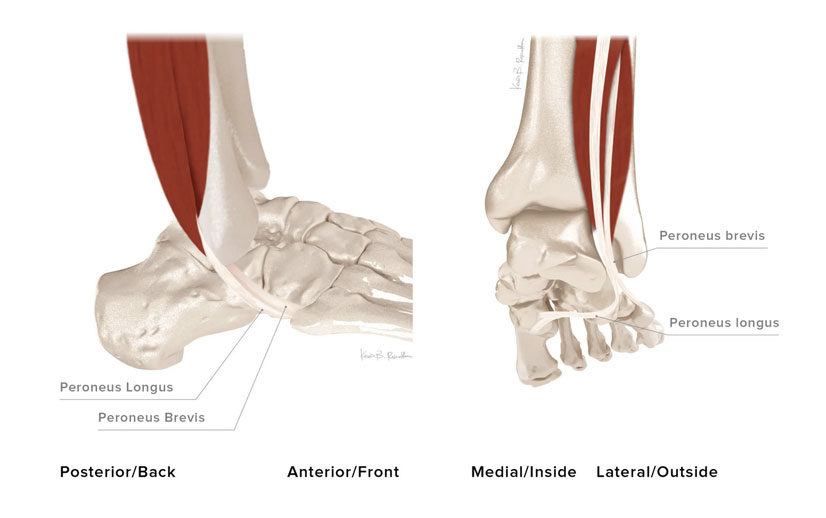The peroneal tendons are fascinating and complex. First of all, there are 2 of them which can get injured together, but normally separate. Like the posterior tibial tendon, when it is in overuse, the peroneal tendons can hurt in many locations. Combined they are both medial and lateral foot stabilizers, therefore can function in medial (pronatory) and lateral (supinatory) stabilization of the foot. I personally think that the peroneus longus is one of the most incredible muscle tendon complexes. And, when we think about muscle tendon location from origin to insertion, these locations can all be the weak link of the chain for a tendon where pain presents.

The peroneus brevis originates along the lower ½ of the fibula, runs first behind the lateral malleolus, then below the lateral malleolus, and along the lateral side of the calcaneus, cuboid, finally inserting into the styloid process of the 5th metatarsal. Peroneus brevis pain can be anywhere along this route.
The peroneus longus originates along the upper and middle ⅓ of the fibula, and like the peroneus brevis runs behind the lateral malleolus, under the lateral malleolus and along the lateral side of the calcaneus, proximal cuboid, before running in a groove under the cuboid, under the cuneiforms, attaching into the medial cuneiform and first metatarsal base plantarly.
The peroneus longus pain can be located anywhere along this route.
The peroneus brevis can anatomically have multiple slits that look like tears on MRI, but be completely normal.
Let’s look at the many functions of these 2 muscle/tendon complexes, that in an overload scenario, can produce pain. These include:
- Stabilization of the lateral fibula, and lateral side of the lower extremity, much as the Ilio-Tibial Band does at the femur
- Stabilization of the lateral ankle, decelerating supinatory moments or rotational torque, and acceleration of pronatory moments
- Stabilization of the lateral cuboid and calcaneal cuboid articulation
- Stabilization of the lateral midfoot
- Acceleration of the forefoot abduction on the rearfoot in pronatory movement
- Whereas, the peroneus brevis stabilizes the lateral side of the cuboid, the peroneus longus stabilizes the plantar aspect of the cuboid and plantar midfoot
- Stabilization of the first metatarsal, deceleration of arch collapse, acceleration of supination and the windlass effect (dependent on the cuboid position being plantar to the first met base)
Thinking about the biomechanics of muscle function when they are part of an injury or pain syndrome is always fun stuff. For the same complaining tendon, you can see why the patient may complain of arch pain, metatarsal pain, lateral ankle pain, leg pain, and only be talking about the misfiring and fatigue of one tendon (in this case the peroneus longus). This is called a pain syndrome, where you can relate one thing to many things. This would be called peroneus longus syndrome with presenting pain in 4-5 locations all at once.
Next week I will begin to show you how to develop strategies of treatment for both peroneus brevis and peroneus longus injuries, with emphasis on orthotic management of course.






